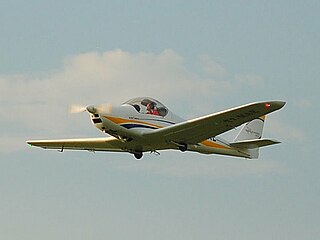Related Research Articles

The Kappa 77 KP-2U Sova, later produced as the Jihlavan KP-2U Skyleader and most recently as the Jihlavan Skyleader, is a two-seat civil utility aircraft designed in the Czech Republic and available in kit form for home building. It is a conventional low-wing monoplane featuring all-metal construction and tricycle undercarriage.

The Schempp-Hirth Janus is a high performance two-seat glider that was built by Schempp-Hirth GmbH. It was the first high-performance two-seater.

The Coavio DF 2000 is a single-engine, high-wing all-metal ultralight aircraft with side-by-side seating for two. Built in Italy, production began in 2004.

The B&F Fk14 Polaris, also called the FK-Lightplanes FK14, is a single-engine, low-wing ultralight aircraft that seats two side by side. Designed in Germany in the late 1990s, it remains in production as of 2011.

The TL Ultralight TL-96 Star is a single-engine, side-by-side configuration two seat ultralight, designed in the Czech Republic in the 1990s. More than 150 have been registered.

The Tecnam P2008 is a single-engine, high-wing two-seat aircraft built in Italy but aimed at the US market. It is the first Tecnam aircraft to incorporate major composite components. It was introduced at the AERO Friedrichshafen 2009 show, with first deliveries in December 2009.
The Kieger AK3 is conventionally laid out single engine, tractor configuration, low wing two seat light aircraft built in France from 2006. At least two have flown.
The Elitar-202 or Elitar 202 is a conventionally laid out, single engine ultralight aircraft which seats two in side-by-side configuration. Designed in Russia, production of the Type 202 began in 2003.

The TL Ultralight TL-3000 Sirius is a conventional single engine high wing ultralight and Light-sport aircraft seating two side-by-side. It was designed and is produced in the Czech Republic.

The Jora Jora is a high wing, T-tail, single-engine, two-seat ultralight designed in the Czech Republic in 1993. More than 160 had been sold by 2009.
The MFI BA-12 Sländan is a single seat ultralight of pod and high boom configuration and with a butterfly tail. It was designed and built in Sweden in the 1980s and led to a two-seat, slightly larger, development called the BA-14.

The Blackshape Prime is an Italian ultralight aircraft, produced by Blackshape srl, the company founded in Monopoli by Luciano Belviso and Angelo Petrosillo. The aircraft first flew in 2007 and was introduced at the Aero show held in Friedrichshafen in 2009. It is supplied as a complete ready-to-fly-aircraft.

The Aviakit Véga is an ultralight aircraft seating two in side-by-side configuration. It was designed in France in the late 1990s to be easily constructed by amateurs from kits and was offered with a choice of three engines and of tricycle or conventional undercarriages.

The Alpi Pioneer 400 is an Italian four-seat light aircraft, designed produced by Alpi Aviation, of Pordenone. The aircraft is supplied as a kit for amateur construction or as a complete ready-to-fly-aircraft.

The Gidroplane Tsikada is a light, twin engined utility aircraft, seating two or four in different variants, developed in Russia since about 2000.
The ViS Sprint is a pusher configuration, pod-and-boom two-seat ultralight, designed and built in the Ukraine in the mid-2000s. It can serve as an agricultural spraying aircraft.

The ViS ViS-3 is a high wing, single-engine ultralight, designed and built in Ukraine. The production version is designated as KhAZ-30 (ХАЗ-30).
The Softeks V-24 Lastivka is a four seat, twin pusher engined utility aircraft, designed and built in Ukraine in the 2010s for survey and transport work. The first prototype flew late in 2012.
The Wolfsberg Aircraft Sparrow ML is a twin boom, pusher configuration ultralight aircraft seating two in tandem. Designed and built in the Czech Republic.
The Marc Parrot, named after the Punta Parrot peak in the Monte Rosa Massif, was specifically designed to fly into unprepared fields and mountain landing strips. The prototype first flew in 2013 but no more had been completed by about 2015.